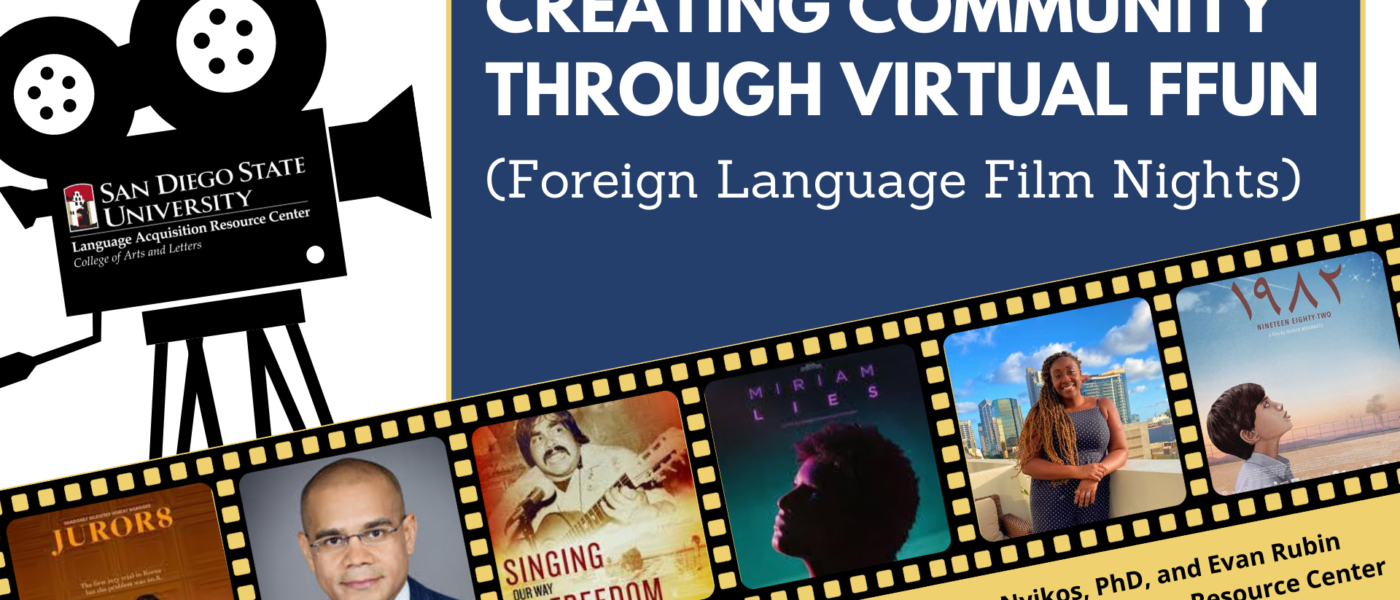Creating Community through Virtual FFuN (Foreign Language Film Nights)
By Stacy Nyikos, PhD, and Evan Rubin SDSU Language Acquisition Resource Center


The Foreign Language Film Night (FFuN) series at San Diego State University’s Language Acquisition Resource Center (SDSU-LARC) began as an in-person movie night in Fall 2019 to increase awareness of LARC’s language labs and contribute to the extracurricular events that the SDSU language learning community offers. When the California State University (CSU) system went completely virtual in March 2020 and stayed that way throughout the 2020-2021 year, both the goal and the series seemed doomed to fail. Instructor participation, flexibility, and consistency helped us rethink our goals and create a series that has gone far beyond our initial goal. Virtually.
The original FFuN series ran every Wednesday night during the Fall 2019 semester from 7 – 9 pm Pacific Time, screening one foreign language film each week (16 total) in one of LARC’s two language labs. The broad parameters regarding film choice were that each be primarily in a language taught at SDSU or by LARC, with English subtitles.
To garner stakeholder buy-in, we reached out to the language departments and collaborated with faculty for the screenings. Often, this took the form of a faculty member attending a screening and introducing the film, sharing interesting facts, and then leading a discussion afterwards. There were no specific parameters set for instructors. Rather, we asked them to share what they thought would be most useful to know either about the film, the culture in which the story is set, or both. Their students would attend, often for extra credit.
To market the films, we devised a weekly, multi-step process that was rolled out each Monday/Tuesday. This timeframe seemed the sweet spot for attracting attention (and not losing it again) before the screening on Wednesday. First, we created a flyer with an image of the movie poster, screening day and time, and a short phrase capturing the essence of the film. These were hung on doors and bulletin boards on campus. Second, we sent an email via MailChimp to various potential on-campus audiences. The email included the movie poster image, online screening information, a link to the film’s trailer, and a synopsis of the film. Third, condensed information – the film poster, screening date, and a short synopsis – was posted on social media – Facebook, Twitter, and Instagram – for students. Fourth, we sent the same information in jpg format to the university’s marketing and Housing departments to link to in weekly email blasts. Note that it was helpful to have all of the essential film information in one file in a design app (InDesign) to reformat to fit various media outlet requirements.
Attendance varied across films. Audience-size was small (5-7) for films in languages not taught recently by the Center (e.g., Dutch), and was larger (15-30) for films for which an instructor of the film’s language attended and led discussion. Turnout was also higher for films for which a language program had a language club (e.g., French), and for films that seemed to have a higher rate of word of mouth publicity. Overall, attendance thinned in the lead-up to finals.
In Spring 2020, we moved screenings to Fridays at noon in the hopes it might increase viewership. Few classes take place at this time, freeing up both instructors and students. It was an idea that was great in theory and horrible in practice. Attendance plummeted. Fewer students came, despite continued instructor attendance and buy-in. Worse still, San Diego community participation completely dried up. The series was in dire straits.
And then the pandemic struck.
The drastic change to virtual everything seemed like the proverbial last nail in the suffering series’s coffin. Instead, it inspired us to rethink and rebuild.
The first aspect we tackled was the goal. It was no longer possible to increase awareness about the labs; they were closed. However, the need for ways to alleviate stress and isolation had significantly increased. We thought art in the form of films could serve as a ray of light in an otherwise bleak time.
With the new goal identified, we focused on delivery. In-person screenings were not possible for a variety of reasons – Zoom was new for the Center, remote digital media distribution made the center/program carefully scrutinize its approach to public viewing rights, especially since those rights were being revisited and reviewed by film distributors, and viewers needed a ray of light when they needed it. Everything pointed to asynchronous screenings. By asynchronous, we mean each person viewed when they wanted, how they wanted. There was no “at the same time” viewing or discussion. FFuN became a weekly film suggestion, at least at first.
For the sake of familiarity, we structured marketing around the original screening day and time: Wednesdays at 7 pm, which pushed email alerts and social media blasts back to Monday/Tuesday. Marketing also took on a more informal, conversational tone. If we couldn’t watch together, we could at least create a sense of community through tone. Finally, feeling personally the increasing need for a regular morale boost, we made most screenings a double feature, adding an inspirational film e.g., The Boy Who Harnessed the Wind (Malawi 2019), to the scheduled one.
One immediate advantage the series saw was an increase in its on-campus exposure. This was driven in part by the fact that there were not many events to market during Spring 2020. Before long, interesting things began to happen.
Emails began to arrive–ones we had not gotten prior to the world’s all-virtual turn –commenting on the films, or thanking us for the series, or highlighting FFuN as that one bright spot in the week. They continued throughout the spring and into summer. When the CSU system decided to remain virtual for the 2020-21 year, new emails began to arrive with suggestions not only for films but also for funding and expansion opportunities. Stakeholders outside the College of Arts & Letters contacted us to collaborate. And there was now a familiar way to do it: Zoom had become part and parcel of everyday life. FFuN was reborn.
We received an internal grant from the College of Arts and Letters to screen two films live and synchronously for the public in Fall 2020. This meant reaching out to distributors to purchase public viewing rights, which came with a small mountain of reimbursement paperwork. Films themselves arrived in mp4 format via dropbox or a zipped file. The series creative director and collaborator shared the load of creating and sharing marketing materials in their respective colleges. The FFuN creative director handled external marketing.
We were also able to reconnect with some of the instructors who had been active with the in-person films in Fall 2019. Ultimately, we arranged for seven films to be screened as live “class” films. This meant the instructor added to the class schedule as an extra credit assignment. Some instructors came to the viewings and guided discussion, and some didn’t. Discussions that were structured by the instructor were structured as the instructor wanted. This was very informal, a chance to meet in real time and chat about a film. Importantly, the film was not open to the public, only the class. This was done in no small part to keep the series within the boundaries of public viewing rights.
In total, two films would be screened publicly and synchronously, seven as class films synchronously, and the remaining six as asynchronous films, that is as the weekly film suggestion.
Given the virtual nature of the public, synchronous screenings, we saw another opportunity to grow our community of viewers. We reached out to our local public branch library, College-Rolando. Since libraries were closed to patrons, the virtual screenings gave the branch another way to connect with its patrons. The youth librarian took on the project and began to share information about the asynchronous and synchronous screenings.
The film Juror 8 (South Korea), was our first public synchronous screening on September 30, 2020. Fifteen people joined the screening and engaged in a lively debate afterwards led in part by one of the SDSU Korean instructors.
The second screening was a suggestion from a colleague in the College of Education, Singing our Way to Freedom. The documentary was made by a local San Diego filmmaker about a local musician, SDSU alumnus, NEA award-winner, activist, and Chicano, Ramon “Chunky” Sanchez. The colleague and Dean of the College of Arts and Letters invited three discussants, all of whom had known Mr. Sanchez in some capacity.
We had a local theme, another college on campus as a collaborator, and expert discussants. The film’s turnout of 60 people broke all records for FFuN, and SDSU’s president made an informal appearance. The new model worked. We decided to build on the success.
We decided to add formal, paid discussants to public, synchronous screenings and bump the number from two to six films for Spring 2021. To cover the costs of public viewing rights and discussant honoraria, we applied for a California Humanities Quick Grant.
When the grant was not awarded, LARC’s director was able to divert some discretionary funding to the proposed Spring 2021 format.
Over Winter Break, we reached out to language instructors to collaborate on “class” screenings again and brought the number of synchronous screenings to eleven. Information about the rest of the films would be shared to view asynchronously.
We collaborated with our local branch library again, and through their help, partnered with the San Diego County Library system at large. Now information about the films, synchronous and asynchronous, would go out to all county library patrons across San Diego.
| Screening Date | Film | Country | Year | Viewers |
| 2021-01-27 | The Perfect Secret | Germany | 2019 | 51 |
| 2021-02-17 | Mosul | Iraq | 2019 | 143 |
| 2021-03-03 | 1982 | Lebanon | 2020 | 39 |
| 2021-03-24 | Miriam Lies | Dominican Republic | 2020 | 24 |
| 2021-04-07 | Love is War | Nigeria | 2019 | 22 |
| 2021-04-28 | Innocence | South Korea | 2020 | 40 |
There were excellent audiences for all films, and a record-breaking 140 participants for the Iraqi film. That brought an unexpected logistics issue. Many of the participants knew each other and greeted one another as they entered Zoom. It got a little chaotic. During the post-film, they spoke up spontaneously. Again, the situation verged on getting too boisterous and spontaneous. The discussants, however, knew many participants as students and were able to redirect and refocus everyone quickly. What could have turned into cacophony was instead a moving, animated, and respectful discussion.
Overall, there did not appear to be one factor that accounted for the fluctuation in high and low turnout. For instance, both films with the lowest turnout had either a celebrity discussant (main actor) or guest speaker (nationally renowned theater director). The highest turnout for the Iraqi film is perhaps easiest to explain. The Iraqi population in El Cajon, a suburb of San Diego, is the largest outside of Iraq. LARC teaches Iraqi and has a strong connection to the community. Two of the instructors served as discussants on the film and shared the event with their students outside of SDSU. “Class” screenings elicited familiar patterns – if an instructor took part in the Zoom screening and discussion, attendance was higher than if an instructor offered extra credit but did not attend. And once again, as the end of the semester approached, instructor and student participation dropped off.
Technology Tips
We have some tips for those that might want to host a similar type of film series.
Technology: To screen films for the public, online, two things are needed: 1) public viewing rights, 2) a screening platform.
Public viewing rights range from extremely easy to nearly impossible to purchase. They generally run approximately $400 / film / viewing. The larger the distributor, overall, the more difficult it is to obtain viewing rights. A helpful suggestion is to work with a film faculty member or a librarian at your institution. Either often knows how best to contact a distributor, which ones are easy or difficult to work with, and the chances of obtaining viewing rights. There are also a number of online distribution platforms, such as VULR.
Most film festivals that moved online during the pandemic used a screening platform. These offer features such as the ability to collect emails of participants, to maintain a closed screening, and to sell online tickets, but given the capabilities of Zoom and that it is free to SDSU departments, we chose to stick with that platform. It had worked well for the two synchronous screenings in the Fall 2020. Note that some distributors will not release a film for public viewing unless it is screened on a streaming platform.
One issue that did occur for a select number of viewers was low sound quality. The issue seemed to be confined to a very few viewers, which led to the supposition that the problem may have been with end-user equipment, rather than the streaming platform.
The tools we armed ourselves with against potential Zoom bombing were: 1) a waiting room, 2) the ability for the host to mute all, as well as remove participants.
Lessons Learned
There were many lessons learned during the evolution of FFuN from entirely in-person to an exclusively online series.
The three most helpful for us are:
1) Pick an evening that would serve as the regularly-scheduled time for the screenings. This helps structure marketing campaigns and create a familiar pattern for viewers.
2) Instructors are the champions that can inspire students to attend.
3) Be flexible, very flexible. Our ability to change the goal to fit the circumstances allowed FFuN to enjoy a steady increase in viewers.
Flexibility will also be a superpower moving forward. For Fall 2021, we will maintain a hybrid screening model. We will screen films simultaneously in-person and virtually for two reasons. First, it gives viewers the greatest discretion for purposes of health, safety, and personal ease. Second, we predict more viewing choices will boost viewer numbers. In addition, not all in-person screenings will be shown in our labs. We are in discussions with our public branch library and the Hillel Center to screen movies at their locations to engage new viewers. Screening at different partners’ venues also opens up the potential to share public viewing rights costs in some instances. It also enables us to take the series on the road and reach more and different audiences.
FFuN has evolved far beyond its original purpose to to increase awareness of LARC’s language labs. It has become a community builder, an illuminator of languages and cultures of the world and Southern California, and an escape to places unknown without leaving home. With the lessons we have learned, we hope to continue to evolve FFuN. Paraphrasing the illustrious words of one of San Diego’s most well-known citizens, Dr. Seuss: Oh, the places it could go!


Thanks for sharing your experience and advice. This is quite inspiring! We did this one a very small scale last year and I am looking forward to doubling our efforts in the semesters ahead.